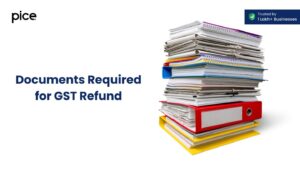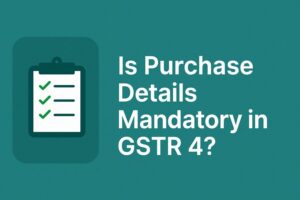Annexure-2 for GST
- 13 Aug 24
- 9 mins

Annexure-2 for GST
Key Takeaway
- FORM GST ANX-2 simplifies GST compliance by providing a real-time view of inward supplies for efficient verification and reconciliation.
- Accurate handling of FORM GST ANX-2 entries is crucial for optimizing input tax credit and ensuring smooth vendor payments.
- Staying informed and vigilant about the contents and implications of FORM GST ANX-2 entries is essential for seamless tax compliance and reporting.
Understanding FORM GST ANX-2
FORM ANX-2 is an annexure under the GST regime, designed to facilitate the auto-drafting of inward supplies for recipients.

It serves as a statement of inward supplies, auto-populated for a recipient based on the basic details furnished by their suppliers in FORM GST ANX-1. This form is integral to the new return system under GST, aiming to simplify the process of filing returns and enhancing the accuracy of data captured in the GST system.
The primary objective of GST ANX-2 Form is to provide a transparent, real-time basis view of the supplies received, enabling businesses to verify and reconcile their purchase transactions efficiently. This form encompasses details of both taxable and non-taxable inward supplies, including imports and supplies received from unregistered persons.
It essentially ensures that the input tax credit (ITC) claimed by businesses aligns with the tax details submitted by their suppliers, fostering a streamlined ITC reconciliation process.
Exploring the Contents of FORM GST ANX-2
Exploring the contents of FORM GST ANX-2 is akin to unveiling the building blocks of managing and reconciling inward supplies under the Goods and Services Tax (GST) framework in India. This form, pivotal for recipients of supplies, is auto-populated based on the information supplied by their vendors in FORM GST ANX-1, making it a crucial document for verifying purchase transactions and facilitating a seamless input tax credit (ITC) process. Let's delve into the specifics that constitute FORM GST ANX-2:
- GSTIN of Supplier: This is the unique identifier for the business that has supplied goods or services, crucial for tracking and verifying transactions within the GST ecosystem.
- Document Details: It includes the type of document (invoice, credit note, etc.), its number, and the date of issue. These details are essential for correlating transactions recorded in accounting books with those reported under GST.
- HSN/SAC Codes: The Harmonized System of Nomenclature (HSN) code for goods and the Service Accounting Code (SAC) for services are listed. These codes help categorize the supplies, facilitating standardized reporting and analysis across businesses and industries.
- Taxable Value: The value of the supply on which tax is to be calculated is specified, laying the groundwork for determining the tax liability accurately.
- Tax Amount: This section details the tax applied on the supplies, broken down into Central GST, State GST, Integrated GST, and cess, if any. It forms the basis for computing the ITC that the recipient is eligible to claim.
- Place of Supply: With GST being a destination-based tax, identifying the place of supply is crucial for determining whether Central GST and State GST or Integrated GST applies to a transaction.
- Amendments: Any corrections or modifications to previously filing of return are highlighted, ensuring that the recipient is aware of and can validate changes affecting their ITC claims.
- Action Taken: Recipients have the option to take actions such as accept, reject, or mark as pending any item within FORM GST ANX-2. This feature empowers them to manage discrepancies and ensure that their tax filings reflect accurate and verifiable data.
Exploring the contents of FORM GST ANX-2 reveals its role as not just a form but a tool for enhancing transparency and efficiency in the ITC process. It underscores the collaborative nature of tax compliance in the GST regime, where both suppliers and recipients of goods and services play active roles in ensuring the accuracy and integrity of reported transactions. This cooperative approach is fundamental to realizing the full benefits of the GST system, fostering trust and accountability among taxpayers.
Key Considerations for Taxpayers Filing FORM GST ANX-2
When dealing with FORM GST ANX-2, taxpayers must navigate a series of strategic considerations to ensure accuracy, compliance, and optimal utilization of the input tax credit (ITC). Here are the key considerations for taxpayers filing FORM GST ANX-2:
- Accuracy in Verification: Given that FORM GST ANX-2 is auto-populated based on suppliers' submissions in FORM GST ANX-1, recipients need to rigorously verify the details against their own purchase records. This step is critical to ensure that all inward supplies are correctly accounted for and match the business's records.
- Reconciliation of Input Tax Credit: Taxpayers must reconcile the ITC available as per FORM GST ANX-2 with their purchase register. This reconciliation process is crucial for identifying discrepancies early and taking corrective measures, ensuring that the ITC claimed is accurate and substantiated, thereby avoiding potential future liabilities or penalties.
- Dealing with Discrepancies: Any mismatch or error found during verification should be addressed promptly. Taxpayers should communicate with their suppliers to rectify any discrepancies in their subsequent filings. Keeping a meticulous track of these communications and corrections is vital for audit trails and future reference.
- Understanding the Implications of Actions Taken: Actions such as accepting, rejecting, or marking transactions as pending have specific implications on the ITC claim and compliance status. Taxpayers need to understand the consequences of these actions thoroughly. For instance, accepting a transaction means agreeing to the details as furnished by the supplier, which directly impacts the ITC claim.
- Staying Updated with GST Provisions: The GST law and its procedural aspects are subject to periodic updates by the authorities. Staying informed about the latest developments related to FORM GST ANX-2 and the broader GST framework is essential for maintaining compliance and leveraging the available provisions effectively.
- Timely Filing and Follow-ups: Ensuring that FORM GST ANX-2 is reviewed and any necessary actions are taken within the prescribed timelines is key to seamless tax filing. Prompt follow-ups with suppliers regarding any discrepancies and ensuring their resolution within the GST filing deadlines are crucial for smooth ITC claims.
- Documentation and Record-keeping: Maintaining comprehensive records of all transactions, communications with suppliers regarding discrepancies, and corrections made is indispensable. These records will be invaluable during audits and for any queries from the tax authorities.
- Professional Consultation: Considering the complexities involved in GST compliance and the nuances of managing ITC through FORM GST ANX-2, seeking professional advice from GST experts or consultants can be prudent. This can provide clarity, ensure adherence to best practices, and mitigate compliance risks.
By adhering to these considerations, taxpayers can navigate the intricacies of filing FORM GST ANX-2 more effectively, ensuring that their business remains compliant while maximizing the benefits of the GST system.
💡If you want to pay your GST with Credit Card, then download Pice Business Payment App. Pice is the one stop app for all paying all your business expenses.
 By
By 

















